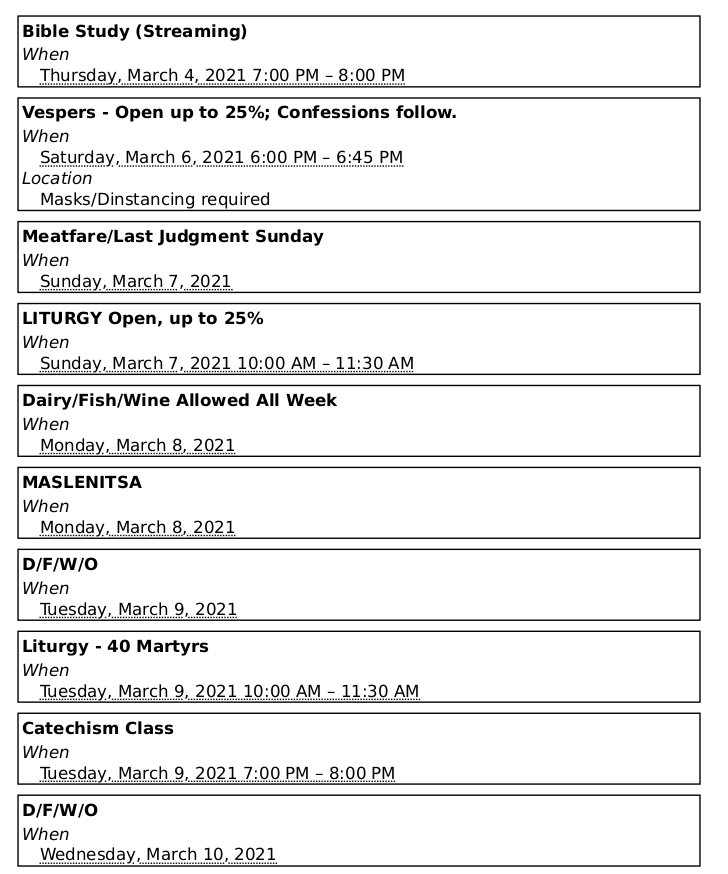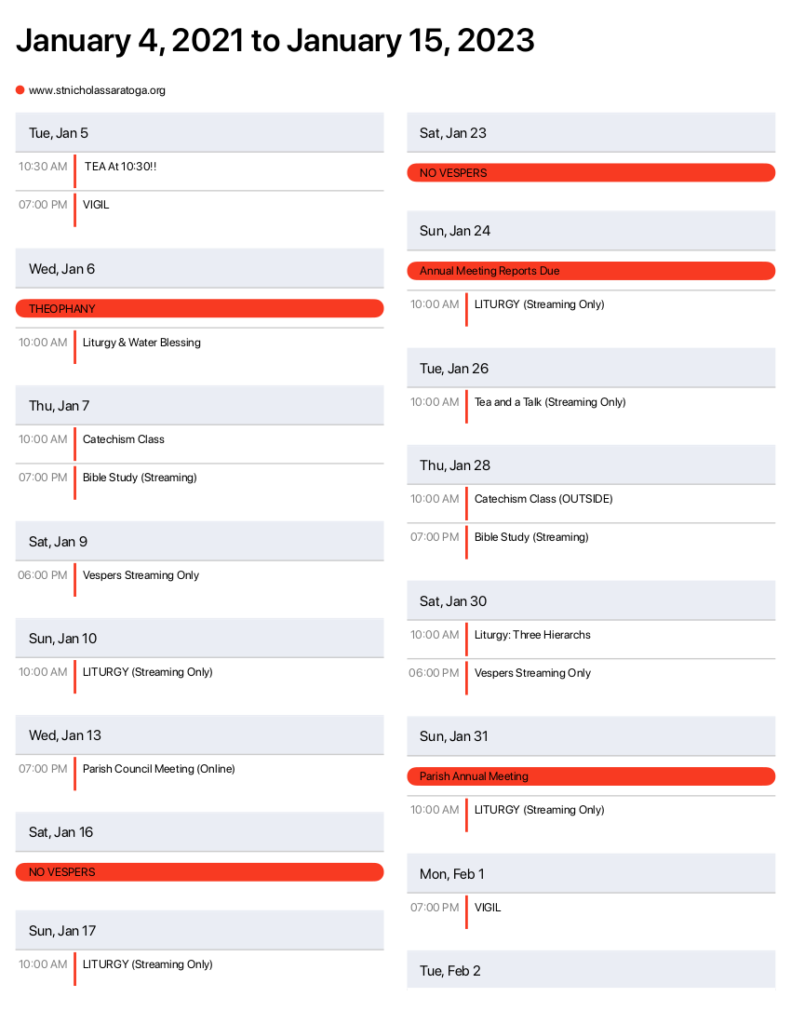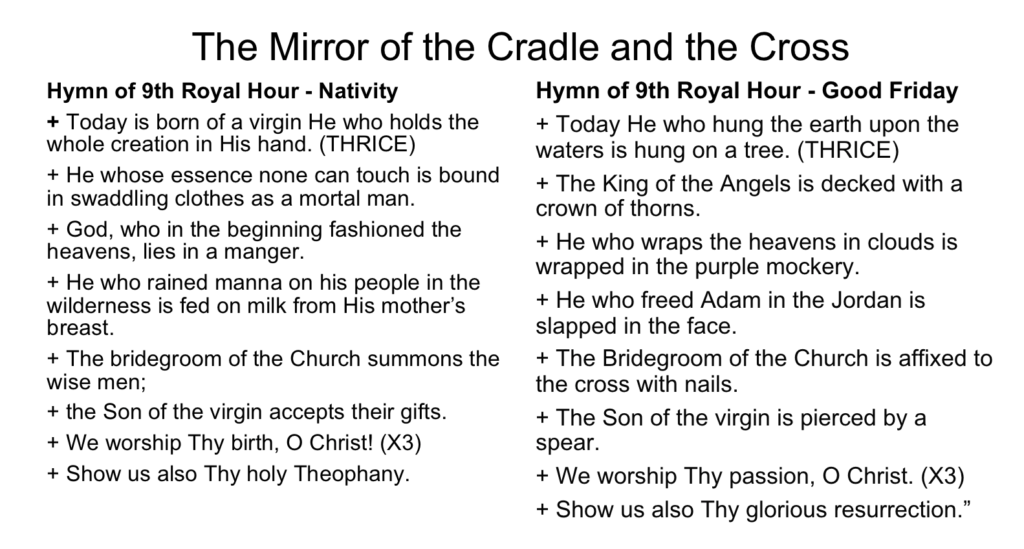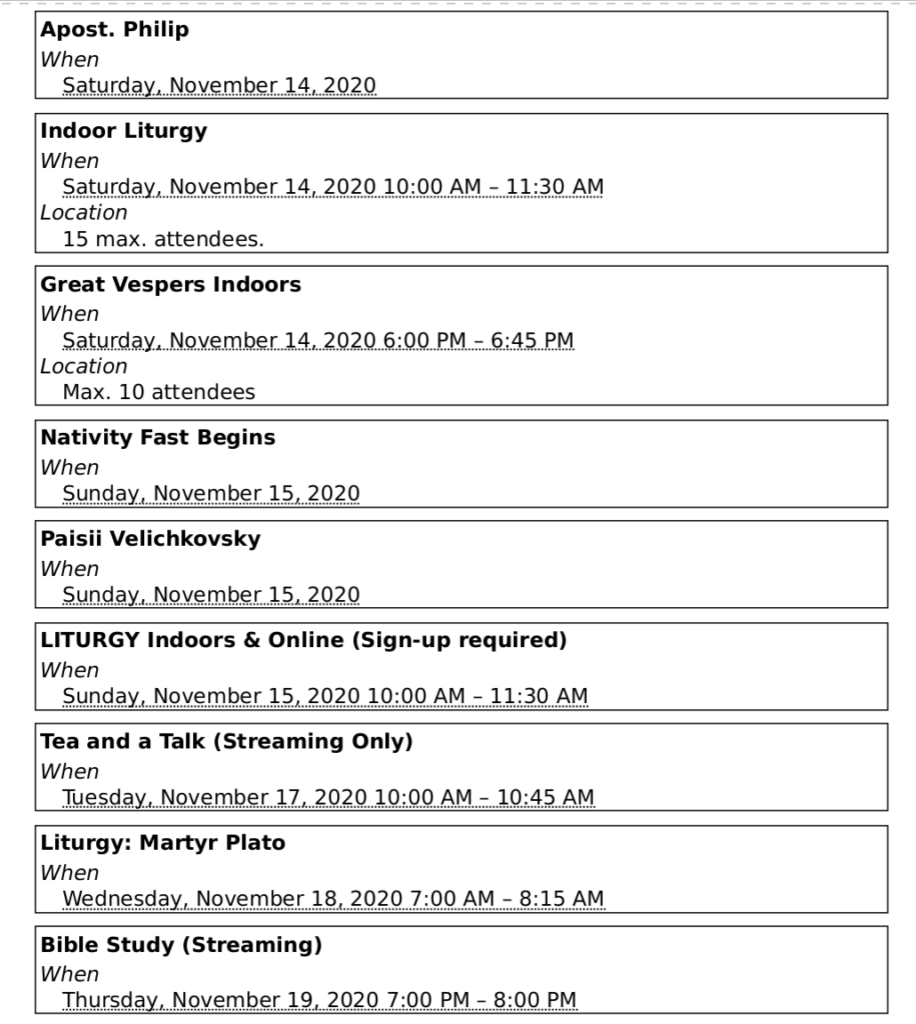

Order your Kulich and Pascha Online Now!
The Pascha Bake Sale is now open! You can order your Kulich and Pascha online, and pay now or when you pick-up your order between 11:30AM and 1:00PM on Palm Sunday (4/25/2021).
Deadline to Order: 04/18/21
This is one of the significant fundraisers for the parish, so don't deprive the parish or yourself of goodies for Pascha!
Click here to send in your order (Or you can go to the website and click "Pascha Bake Sale" on the menu)
Focus on the Faith: Holy and Great Friday, Sermon at the Plaschanitsa (winding sheet)
Everything is different now. Today we forget about ourselves, our jobs, our worries. In the Church’s hymns starting yesterday on Holy Thursday through to tomorrow, Holy Saturday, you won’t find any mention of us miserable wretches, or our corrupted souls, of our defiled anything. The contemplation of Christ envelopes everything. Our attention to this, our attention to Christ, is essential if we want to participate, or derive any grace from this holy day. If we can pay attention, if we can force our minds, wrestle our thoughts, away from this world, away from this time, and this place, we will find ourselves mystically in Jerusalem, 1,987 years ago. Suddenly, the experience of these days becomes a school of life in Christ and a school of life with Christ. We call ourselves Christians, and so we are. But to call ourselves “Christians” is to also declare ourselves “disciples.” After all, the Scriptures confirm this in Acts 11:26 where St Luke reports that “The disciples were called ‘Christians’ first in Antioch.”
On this Great and Holy Friday, we contemporary and unworthy disciples join those sanctified original disciples in two sorrowful and horrific journeys — the path to Golgotha and the procession to the burial cave. These are the objects of our contemplation and our experience today. It is characteristic of the Divine services that they make us participants in those distant and frightful events. In the garden of Gethsemane, our eyes were blinded by torches, a youth wrapped in a cloth hid among trees, and Peter was warming himself by the fire when he was surprised by a cock crow. We peered into Pilate’s window, were surprised by the many-voiced roar of the crowd, the women of Jerusalem were wailing over the beaten and bloodied Sufferer, the thief was forgiven because of the final love entrusted to the Holy One. And two old men and two grief-stricken women found what they feared might be the final shelter for the Homeless One.
How vividly one sees the faces of Christ’s contemporaries, but He Himself is somehow mystically hidden.But did not St. Isaiah foretell this when he said: “many shall be amazed at thee, so shall thy face be without glory from men, and thy glory by the sons of men. Thus shall many nations wonder at him; and kings shall keep their mouths shut: for they to whom no report was brought concerning him, shall see; and they who have not heard, shall consider.” (Is. 52:14-15). Did you notice that in the description of the suffering of the Innocent One, the Prophet doesn’t express a single word of sympathy for Him? Why is this so? Because he doesn’t need to. This is not a moment for artificial emotionalism or sentimentality, but it is a moment for the Holy Spirit Himself to reveal the depths of these divine realities in our hearts. In this moment, all our thoughts and feelings must be engrossed in the awesome wonder of God’s works, which are beyond our comprehension, revealing “the love of Christ, which passeth understanding” (Ephesians 3:19). But we also see human love, don’t we, and it too is worthy of wonder.
We Orthodox Christians always view the Cross and the Grave from from the vantage point of Pascha, don’t we? We know too well the joy of the Resurrection, we live by it. And the solemn order of the Divine services of Passion Week, grand and mournful as they are, are still permeated with the expectation of Pascha. Its hidden joy colors even the Burial Shroud [Epitaphios, Plaschanitsa], the last covering of the Sufferer. For us the Burial Shroud is the banner of the Resurrection and the triumph of life over death and slavery, the banner of freedom and unity with God. But Nicodemus and the Elder Joseph of Arimathaea, the sorrowful women, and the Mother of God were weeping rivers of tears over the bloody cloth, the modest covering of the Dead One. They saw in the Burial Shroud the clothing of the ancient patriarch Joseph which had been wept over by his father Jacob who said: “I will go down into Hades, unto my son, mourning”(Gen. 37:3).
Can we imagine the grief and despair born of love in such a circumstance? Christ was the most beautiful and sacred being in the lives of these people, but they wonder if this death, too, is irreversible; they worry that not even Jesus can overcome it, in spite of His words to the contrary. They see a dead body, mutilated and bloody, and for a moment they forget the words that Jesus spoke at the Last Supper: “This is my body which is broken for you!” (1 Corinthians 11:24). In spite of these doubts, and despite this overwhelming sadness, what is the response of these myrrh-bearers? Nicodemus no longer conceals his faith in Christ. Joseph risks losing everything he has, and gives his tomb to the Righteous One. They have nothing to hope for and nothing to expect, yet their love is stronger than their fear. Even if Christ, the purest and most sacred being they have ever seen in their lives, is dead, they still assume that they must go down into the grave…mourning.
But this is not the meaning or the purpose of this day. Today, God’s overwhelming love toward His children is revealed. Today we join with those noble and courageous disciples, taking down the body of the incarnate God from the Cross, wrapping it in fine linen, anointing it with spices, and placing it in a new tomb. Amen.
From the Fathers
“If he was not flesh, whom did the Jews arrest? And if he was not God, who gave an order to the earth and threw them onto their faces.
If he was not flesh, who was struck with a blow? And if he was not God, who cured the ear that had been cut off by Peter and restored it to its place?
If he was not flesh, who received spitting on his face? And if he was not God, who breathed the Holy Spirit into the faces of his Apostles?
If he was not flesh, who stood before Pilate at the judgement seat? And if he was not God, who made Pilate’s wife afraid by a dream?
If he was not flesh, whose garments did the soldiers strip off and divide? And if he was not God, how was the sun darkened at the cross?
If he was not flesh, who was hung on the cross? And if he was not God, who shook the earth from its foundations?
If he was not flesh, whose hands and feet were transfixed by nails? And if he was not God, how was the veil of the temple rent, the rocks broken and the graves opened?
If he was not flesh, who cried out, “My God, my God, why have you abandoned me”? And if he was not God, who said “Father, forgive them”?
If he was not flesh, who was hung on a cross with the thieves? And if he was not God, how did he say to the thief, “Today you will be with me in Paradise”?
If he was not flesh, to whom did they offer vinegar and gall? And if he was not God, on hearing whose voice did Hades tremble?
If he was not flesh, whose side did the lance pierce, and blood and water came out? And if he was not God, who smashed to gates of Hades and tear apart it bonds? And at whose command did the imprisoned dead come out?
If he was not flesh, whom did the Apostles see in the upper room? And if he was not God, how did he enter when the doors were shut?
If he was not flesh, the marks of the nails and the lance in whose hands and side did Thomas handle? And if he was not God, to whom did he cry out, “My Lord and my God”?
(St. Efrem the Syrian, Sermon on the Transfiguration)
Orthopraxis: Services of Holy Week & Pascha in the Russian Orthodox Church
“O hills and valleys, the
multitude of men, and all
creation, weep and lament
with me, the Mother of your God.”
Today the grace of the Holy Spirit has gathered us together.
“Today the grace of the Holy Spirit has gathered us together, and we all take up Thy Cross and say: Blessed is He that comes in the name of the Lord; Hosanna in the highest.” These words, sung by the Orthodox Church on Palm Sunday, hearken back to the ancient monasteries in Palestine, where the monks would go into the desert to pray and fast alone through the forty days of Lent, and gather again in the monastery on the eve of Palm Sunday in order to celebrate the Passion and Resurrection of the Lord. Today also the Orthodox, after the fast of the Great Lent, put aside their normal daily occupations, some travelling over great distances to be near a church, for these exceptionally holy days, when they become united more closely with the suffering and risen Lord, and thereby draw closer to their fellow members of their parish or community.
The triumph of Palm Sunday was short lived, and we “make haste… from palms and branches… to the solemn and saving celebration of Christ’s Passion.”
During the first three days of Holy Week we remember the teaching given by Christ after His entry into Jerusalem: the discourse about His Second Coming and the parable of the ten virgins (Matt. Ch. 24 and 25), which are reflected in the hymns for these days.
“Behold the bridegroom comes in the middle of the night; and blessed is the servant whom He shall find watching…”
“I see Thy bridal chamber adorned O my Saviour, and I have no wedding garment that I may enter therein. Make the robe of my soul to shine, O Giver of Light, and save me.”
We pray for spiritual renewal in the days ahead: “O Bridegroom surpassing all in beauty, Thou hast called us to the spiritual feast of Thy bridal chamber. Strip from me the disfigurement of sin, through participation in Thy sufferings; clothe me in the glorious robe of Thy beauty, and in Thy compassion make me feast with joy at Thy Kingdom.”
On Great Thursday we commemorate the institution of the Eucharist at the Last Supper, the washing of the disciples’ feet, and the betrayal of Christ by Judas.
Thursday Evening. The Twelve Gospel Readings of the Passion.
This is the matins of Good Friday. A large Cross is placed in the middle of the church. The clergy, in dark vestments, come into the middle and incense the church as the following troparion is sung: “When the glorious disciples were illumined at the Supper by the washing of the feet, then ungodly Judas was darkened by the disease of avarice, and he delivered Thee, the righteous Judge, to lawless judges. See, O lover of money, how for money’s sake he hanged himself. Flee from the greed which made him dare to do such things against his Master. O Lord who art good towards all men, glory to Thee.”
The first Gospel reading is much the longest, being four chapters from S. John’s Gospel in which, after the Last Supper, Our Saviour consoled and strengthened His disciples in the face of the coming trials; “Ye shall weep and lament, but the world shall rejoice: and ye shall be sorrowful, but your sorrow shall be turned into joy.”
Before each Gospel we sing “Glory to Thy Passion, O Lord, Glory to Thee,” and after each, “Glory to Thy longsuffering, O Lord, glory to Thee.”
In the next four readings we hear of the betrayal, trial and mockery endured by the Saviour. Then in the sixth reading we hear how he was nailed to the Cross. “Today He who hung the earth upon the waters is hung upon the Cross. He who wraps the heaven in clouds is wrapped in the purple of mockery. The Bridegroom of the Church is transfixed with nails. The Son of the Virgin is pierced with a spear.”
The Beatitudes are read and we place ourselves in the position of the robber on the cross: “Grant us also the repentance of the thief, O Christ our God, who alone lovest mankind, for we worship Thee with faith and cry to Thee: Remember us also, Saviour, in Thy kingdom.”
The prophetic verse “My God, My God, why hast Thou forsaken me?” is chanted, then, in the concluding Gospels we hear how the Saviour “gave up the ghost” upon the Cross.
“The whole creation was changed by fear, when it saw Thee, O Christ hanging on the Cross. The sun was darkened and the foundations of the earth were shaken.”
“Thou hast suffered for us and by Thy Passion set us free from passions; in Thy loving self-abasement Thou hast stooped down and raised us up: O almighty Saviour, have mercy on us.”
Friday Afternoon. The Bringing out of the Winding Sheet.
After the usual beginning of vespers, prophesies of Our Lord’s sufferings are read, in particular from the 53rd chapter of Isaiah: “He bears our sins, and is pained for us; yet we accounted him to be in trouble, and in suffering, and in affliction.”
Then, in a long Gospel reading made up of passages from all four evangelists, we hear the account of the Crucifixion for the last time. After this we reach a turning point in the sacred commemorations, as we remember the un-nailing and burial of the Saviour, and turn from the fury of the powers of evil to the quiet grief of the Disciples and all creation.
“Joseph with Nicodemus took Thee down from the Tree, who coverest Thyself with light as with a garment; and looking upon Thee dead, stripped and without burial, in his grief and tender compassion he lamented saying: Woe is me, my sweetest Jesus. . . How shall I bury Thee, my God, How shall I wrap Thee in a winding sheet… O Compassionate Saviour.”
The clergy come out of one of the side doors of the iconostas, bearing above their heads the winding sheet (plaschanitsa or epitaphion), a stiffened piece of fabric on which is depicted an icon of the Saviour’s body as it lay in the tomb. The winding sheet is brought into the middle of the church and laid on the prepared “tomb” as we sing to a slow melody: “Noble Joseph, taking down Thy most pure body from the Tree, wrapped it in clean linen with sweet spices, as he laid it in a new tomb.”
After the dismissal the people come up to venerate the winding sheet, making prostrations to the ground before kissing the wounds on the Saviour’s feet and hands. At the same time the following is sung: ”Come and let us bless Joseph of everlasting memory, who came to Pilate by night and begged for the Life of all: Give me this stranger, who has no place to lay His head. Give me this stranger, whom the evil disciple delivered to death. Give me this stranger, whom His Mother saw hanging on the Cross, and with a mother’s sorrow she cried weeping: Woe is me my Child! Woe is me Light of mine eyes and beloved fruit of my womb! For what Simeon foretold in the temple is come to pass today: a sword pierces my heart; but do Thou change my grief to gladness by Thy Resurrection. We venerate Thy passion, O Christ. We venerate Thy Passion, O Christ. We venerate Thy Passion, O Christ, and Thy Holy Resurrection.”
Friday Evening. The Burial Lamentations.
We now begin the services of Holy Saturday, the “Great and Blessed Sabbath, on which the Only Begotten Son of God rested from His works, keeping Sabbath in the flesh.”
The services of this day combine the opposite feelings of grief and quiet joy at the victory over death and hope in the coming Resurrection. They have been the inspiration of icons such as the one shown on the front of this leaflet. Again “Noble Joseph…” is sung as the clergy come into the centre of the church to begin the burial lamentations before the winding sheet. This is Psalm 118 (which is also read at Orthodox funerals) with special “lamentations” inserted between the verses. “Who will give me water and springs of tears, cried the Virgin Bride of God, that I may weep for my sweet Jesus.”
“O Life, how canst Thou die? How canst Thou dwell in a tomb? Yet Thou dost destroy death’s kingdom and raise the dead from hell.”
“To earth hast Thou come down, O Master, to save Adam: and not finding him on earth, Thou hast descended into hell, seeking him there.”
“All devouring hell received within himself the Rock of Life, and cast forth all the dead that he had swallowed since the beginning of the world.”
The canon, which follows, is one of the most profound hymns of Orthodoxy. “To fill all things with Thy glory, Thou hast gone down into the nethermost parts of the earth: for my person that is in Adam has not been hidden from Thee, but in Thy love for man Thou art buried in the tomb and dost restore me from corruption.”
After the Great Doxology the winding sheet is carried in procession round the church, to the slow singing of “Holy God, Holy Mighty, Holy Immortal One, have mercy on us.”
This is exactly like an Orthodox funeral procession, but it also signifies that Christ is now proceding through the darkness of hell, announcing to Adam and to all the dead His coming Resurrection, in which they are also called to share. The winding sheet is carried up to the Royal Doors with the exclamation “Wisdom, stand aright” to show that Christ is at the same time God on His Heavenly Throne with the Father and the Spirit.
The winding sheet is returned to the “tomb” in the centre of the church. A prophesy is read from Ezekiel (Ch. 37) pointing to the future general resurrection, in which the Lord showed the prophet a vision of a valley full of dry bones: ”I beheld, lo, the sinews and flesh came up upon them… and the breath came into them, and they lived, and stood up upon their feet, an exceeding great army.”
Finally, we are brought back to the present moment by a Gospel reading about the soldiers who “made the sepulchre sure, sealing the stone, and setting a watch.
“Again the faithful come up to venerate the winding sheet, as at the end of vespers, to the singing of “Come and let us bless Joseph of everlasting memory…”
Saturday Morning. Vespers and Liturgy of Saint Basil.
This service is a reverent contemplation of the entire mystery of our salvation, and it is here that we begin the celebration of the Resurrection of Christ. The service begins with the clergy still in dark vestments. After the entrance at vespers, 15 Old Testament prophecies are read. We hear the wonderful prophecies of Isaiah: “That there should be given to them that mourn in Zion glory instead of ashes, the oil of joy to the mourners, the garment of glory for the spirit of heaviness: and they shall be called generations of righteousness, the planting of the Lord for glory.”(Ch. 61)
“Shine, shine O Jerusalem, for Thy light is come and the glory of the Lord is risen upon Thee. “ (Ch. 6O) We hear of the three children unharmed in the fiery furnace and, with the Royal Doors opened, we join in their song: “Praise the Lord and exult Him above all for ever.”
After the epistle reading, to the singing of “Arise, O God, judge the earth, for Thou shalt have an inheritance among all nations,” the clergy change from dark to bright vestments, and all the coverings in the church are also changed. The deacon comes out in white vestments and reads the Gospel account of the Resurrection from Saint Matthew, ending with the words “Behold I am with you always, even unto the end of the world. Amen.”
At the great entrance of the liturgy we sing: “Let all mortal flesh keep silence, and stand with fear and trembling; and let it take no thought for any earthly thing. For the King of Kings and Lord of Lords draws near to be sacrificed and given as food the faithful.”
The priest and deacon bring the holy gifts out and carry them round the winding sheet into the altar. The hymn continues, “Before Him go the choirs of angels and all the principalities and powers, the many-eyed cherubim and the six-winged seraphim, which cover their faces as they sing this hymn: Alleluia, alleluia, alleluia.”
After receiving Holy Communion, the faithful are given blessed bread and a cup of wine in memory of the days when this service was held late in the afternoon and the faithful stayed in church until the midnight service, and so needed a little food as sustenance.
Saturday Night. Pascha – the Passover of the Lord.
As the faithful gather again in the evening, the church is in darkness. They venerate the winding sheet for the last time and take turns reading from the Acts of the Apostles. At 11:30pm the midnight office begins. This is a repetition of the canon of Holy Saturday. At the end of the canon the priest comes out and brings the winding sheet into the altar to the singing of the final irmos: “Weep not for Me, O Mother, beholding in the tomb the Son whom thou hast conceived without seed in thy womb. For I shall arise, and shall be glorified, and as God I shall exalt in everlasting glory those who magnify Thee with faith and love.”
Shortly before midnight the clergy in the altar quietly begin the processional hymn: “Thy Resurrection, O Christ our Saviour, the angels hymn in the heavens, grant also to us who are on earth, to glorify Thee with a pure heart.” This is sung softly at first, then more loudly, then it is taken up by the choir and the whole congregation as the clergy come forth from the altar and, preceded by the cross and banners, all go out for the Easter procession carrying lighted candles. This procession symbolises the women who went before the dawn, “bringing sweet spices and ointments” to seek the body of the Saviour. It also symbolises the five wise virgins of the Gospel parable, whose lamps were ready, so that they could enter into the marriage feast.
The procession stops outside the closed doors of the church. The priest intones “Glory to the Holy, Consubstantial, Life-Creating and Undivided Trinity, always, now and ever, and unto the ages of ages.” Then he begins the triumphant Paschal hymn, which is taken up by the choir and people: “Christ is risen from the dead, trampling down death by death, and upon those in the tombs bestowing life.”
The priest intones the Paschal verses: “Let God arise and let His enemies be scattered, and let them that hate Him flee from before His face!” Then, singing repeatedly “Christ is risen from the dead…” all enter the church, now brilliantly lit. This symbolises our entrance into the Heavenly Kingdom, made possible by the power of Christ’s Resurrection.
Indeed, the entire Paschal service is a celebration, not only of Christ’s Resurrection from the dead, of which we have already heard at the Liturgy of Holy Saturday, but also of the future Kingdom, of which we are now granted a foretaste, dependent, however, on the extent of our spiritual preparation.
The joyful Paschal canon is sung while the clergy repeatedly cense the church and greet the people “Christ is Risen!”, to which they reply “He is Risen Indeed!” (Khristos Voskrese! Vo-istinu Voskrese!) “It is the day of Resurrection, let us be radiant O ye people. Pascha, the Lord’s Pascha. From death unto life and from earth unto Heaven has Christ our God led us, singing the song of victory.”
“This is the chosen and holy Day, the one King and Lord of Sabbaths, the Feast of Feasts, and the Triumph of Triumphs: wherein let us bless Christ for evermore.” The Paschal sermon of S. John Chrysostom is read and the people greet one another, kissing each other three times, saying, “Christ is Risen! He is Risen Indeed!”
Matins is immediately followed by the Liturgy, at which the Gospel from Saint John, chapter 1 -”In the beginning was the Word…” is read in many languages as a sign of Christ’s truth being proclaimed to all men. In a sense the Liturgy is the most truly Paschal of all the Paschal services, and is understood most profoundly on this day, since in it we are truly united with Christ in Holy Communion, which is the culmination of the Paschal celebration.
“O Christ, the Pascha great and most holy! O wisdom, Word and Power of God! Grant that we may more perfectly partake of Thee, in the day of Thy Kingdom which knoweth no eventide.”
“The “cheese-pascha”, eggs and other special foods are blessed, and the people share a festal meal, breaking the seven week long fast. They depart for their homes bearing in their hearts the joy of the Risen Christ, as the sun rises over the still sleeping city, which has received, unawares, a blessing from the sacred rites which have been celebrated within its precincts. For the entire week after Easter the services repeat the joyous hymns of the Paschal night. The Prayer Book contains the complete text, which may be read or sung by the faithful at home if they are unable to attend these services in church. As we return to our normal life of prayer and work, we are strengthened in our resolve to live as Christ commanded, to pray and struggle to be worthy of Christ’s future Kingdom, of which we have reached a pledge, an annual foretaste of paradise, in the Paschal celebrations.
Upcoming Events
Upcoming events this month (Events are subject to change! see the online calendar for updates or the attached PDF for more info)







